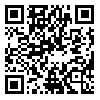Volume 6, Issue 2 (Volume 6, Number 2 2015)
jdc 2015, 6(2): 79-84 |
Back to browse issues page
Download citation:
BibTeX | RIS | EndNote | Medlars | ProCite | Reference Manager | RefWorks
Send citation to:



BibTeX | RIS | EndNote | Medlars | ProCite | Reference Manager | RefWorks
Send citation to:
Ghasemi Z, Falahati M, Zaini F, Ghaffarpour G H, Ahmadi F, Eskandari S E. Causative agents of tinea unguium in Razi Hospital, Tehran, Iran in 2010 and 2011. jdc 2015; 6 (2) :79-84
URL: http://jdc.tums.ac.ir/article-1-5120-en.html
URL: http://jdc.tums.ac.ir/article-1-5120-en.html
Zeinab Ghasemi1 
 , Mehraban Falahati *
, Mehraban Falahati * 
 2, Farideh Zaini1
2, Farideh Zaini1 
 , Gholam Hossein Ghaffarpour3
, Gholam Hossein Ghaffarpour3 
 , Farzaneh Ahmadi4
, Farzaneh Ahmadi4 
 , Seyed Ebrahim Eskandari5
, Seyed Ebrahim Eskandari5 


 , Mehraban Falahati *
, Mehraban Falahati * 
 2, Farideh Zaini1
2, Farideh Zaini1 
 , Gholam Hossein Ghaffarpour3
, Gholam Hossein Ghaffarpour3 
 , Farzaneh Ahmadi4
, Farzaneh Ahmadi4 
 , Seyed Ebrahim Eskandari5
, Seyed Ebrahim Eskandari5 

1- Department of Parasitology and Mycology, School of Public Health, Tehran University of Medical Sciences, Tehran, Iran
2- Department of Parasitology and Mycology, School of Medicine, Iran University of Medical Sciences, Tehran, Iran
3- Department of Dermatology, Iran University of Medical Sciences, Tehran, Iran
4- Department of Biostatistic, Shahid Beheshti University of Medical Sciences, Tehran, Iran
5- Center for Research and Training in Skin Diseases and Leprosy, Tehran University of Medical Sciences, Tehran, Iran
2- Department of Parasitology and Mycology, School of Medicine, Iran University of Medical Sciences, Tehran, Iran
3- Department of Dermatology, Iran University of Medical Sciences, Tehran, Iran
4- Department of Biostatistic, Shahid Beheshti University of Medical Sciences, Tehran, Iran
5- Center for Research and Training in Skin Diseases and Leprosy, Tehran University of Medical Sciences, Tehran, Iran
Abstract: (7646 Views)
Background and Aim: Tinea unguium is a common disease with worldwide distribution most commonly seen in adult patients. Trichophyton rubrum and T. interdigital are the most common causes. The aim of this study was to investigate the frequency of tinea unguium causative agents in a referral dermatology hospital in Tehran, Iran.
Methods: This cross sectional study was conducted in 2010 and 2011 on clinically suspicious patients for tinea unguium referred to the Mycology Laboratory, Razi Hospital, Tehran, Iran. Samples from 700 patients were examined using direct smear microscopy and culture. Direct microscopic examination of the specimens was carried out using 20% potassium hydroxide solution. The specimens were cultured on Sabourad dextrose agar culture media containing chloramphenicol and cyclohexamid (Scc). For identifying the species of dermatophytes, complementary tests were used. Frequencies and relative frequencies were demonstrated in tables and chi-square and Fisher's exact tests were used to investigate any association between the categorical variables.
Results: Of 700 dystrophic nail samples, 53 samples (7.6%) were positive according to both direct examination and culture. Thirty-eight patients were males. The most common clinical type was distal subungual onychomycosis which was observed in 79.2% of cases. The most frequent detected dermatophyte species. was T. interdigital (39.6%) followed by T. rubrum (37.7%). Forty-seven patients had tinea unguium on their toe nails, 4 patients on their finger nails, and 2 patients had it on both finger and toe nails. Nineteen patients had underlying diseases, and the most common underlying disease was cardiovascular disease (26.3%).
Conclusion: Tinea unguium is a disease with worldwide distribution and identifying the causative agents and predisposing factors are necessary for better management of the patients.
Type of Study: Research |
Subject:
Special
Received: 2015/09/1 | Accepted: 2015/09/1 | Published: 2015/09/1
Received: 2015/09/1 | Accepted: 2015/09/1 | Published: 2015/09/1
| Rights and permissions | |
 |
This work is licensed under a Creative Commons Attribution-NonCommercial 4.0 International License. |



